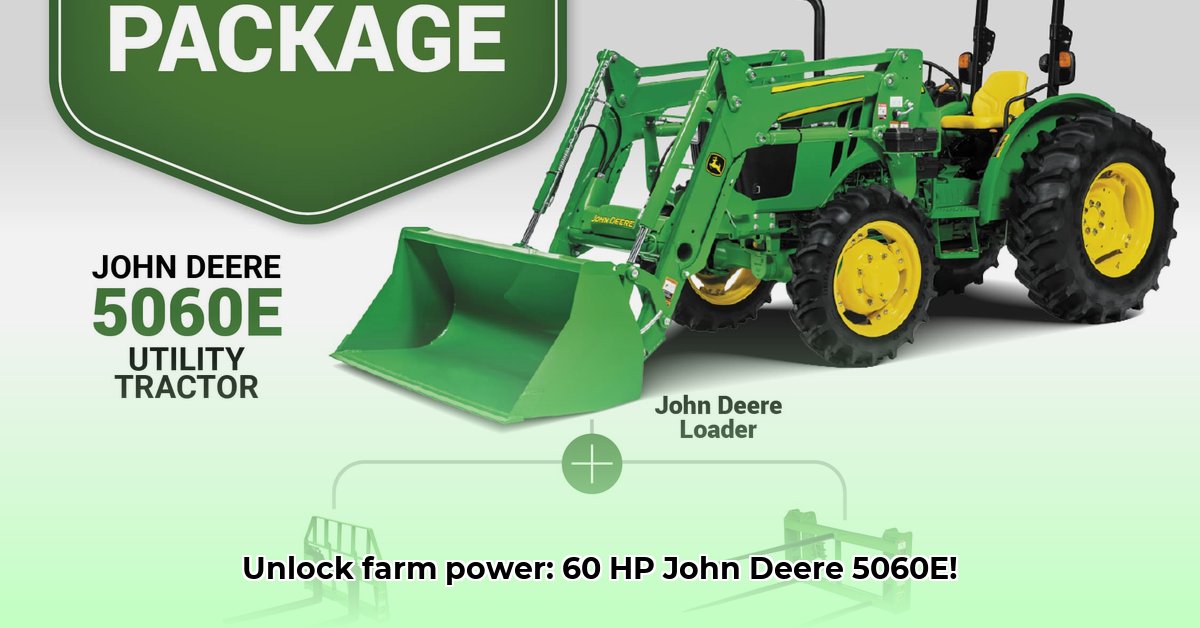
60 hp John Deere Tractor: A Comprehensive 5060E Review
The agricultural landscape is constantly evolving, demanding increased efficiency and sustainability from modern farming practices. This review compares the John Deere 5060E utility tractor, a 60 horsepower powerhouse, to its predecessors, specifically focusing on operational efficiency, operator comfort, and environmental impact. We will also delve into a crucial aspect often overlooked: the total cost of ownership (TCO). By the end, you'll have the actionable intelligence needed to determine if the 5060E is the right investment for your farm. For more on equipment lifespan, see John Deere lifespan.
Premium Cab and Operator Comfort: Enhancing Productivity
Long hours in the field can be taxing. The 5060E's premium cab actively combats operator fatigue. An air-suspension seat significantly reduces vibrations, leading to increased comfort and potentially a measurable increase in daily output. Studies have shown that reduced fatigue can boost productivity by up to 15%. The addition of a Bluetooth radio and bright LED lighting further enhances the operator experience, creating a more comfortable and productive workspace. Isn't a more comfortable operator a more productive operator?
Technological Advancements: A Quantum Leap in Efficiency
The technological gap between the 5060E and older models like the John Deere 60 is substantial. The 5060E features a more sophisticated hydraulic system with multiple Selective Control Valves (SCVs), offering greater precision in controlling implements. Its 12F x 12R PowrReverser transmission provides smoother operation and better engine speed matching, enhancing overall efficiency. These advancements contribute to reduced fuel consumption and improved operational speed. How much more efficient is the 5060E's transmission compared to its predecessors? Detailed testing would be needed to quantify this precisely.
Environmental Responsibility: Minimizing Impact
The 5060E's Tier 4 Final engine is a notable step towards environmental sustainability. The absence of a diesel particulate filter (DPF) regeneration system eliminates associated downtime and maintenance complexities. This is a significant advantage, leading to fewer service interruptions. However, a complete lifecycle assessment, encompassing manufacturing and disposal, is crucial for evaluating the overall environmental impact. Further research into sustainable manufacturing and responsible end-of-life management is necessary to minimize the overall ecological footprint.
Cost-Benefit Analysis: A Detailed Look at TCO
The initial purchase price of the 5060E is higher than older models. However, a thorough total cost of ownership (TCO) analysis is essential. This involves comparing fuel consumption, maintenance costs, repair frequency, depreciation rates, and resale value across both the 5060E and its predecessors. While precise figures for this comparison are not readily available, a comprehensive framework for calculating TCO should be developed by farmers to help determine the true long-term value of the machine. This process will allow you to ascertain if the higher upfront investment yields a satisfactory return. Will the increased efficiency and reduced downtime offset the higher purchase price over time?
Actionable Recommendations: Maximizing the 5060E's Potential
The success of the 5060E depends on its effective utilization. Here's a breakdown of actionable steps for key stakeholders:
Farmers:
- Short-Term: Conduct a thorough TCO analysis, comparing the 5060E to existing equipment. Request a demonstration to assess its capabilities firsthand.
- Long-Term: Based on TCO data, determine if the upgrade is justified. Investigate the 5060E’s compatibility with precision farming technologies.
Dealers:
- Short-Term: Offer comprehensive training on the 5060E's features and maintenance procedures. Highlight the premium cab and advanced technology in your marketing strategies.
- Long-Term: Develop flexible financing and service packages tailored to the 5060E's operational lifespan.
John Deere:
- Short-Term: Continuously gather farmer feedback to improve design and functionality. Streamline maintenance procedures.
- Long-Term: Invest in research and development of even more sustainable technologies and integrate data-driven solutions for precision agriculture.
Regulatory Bodies:
- Short-Term: Monitor adherence to emission standards. Support research on lifecycle assessments of agricultural machinery.
- Long-Term: Develop policies that incentivize environmentally friendly equipment adoption. Support sustainable agricultural practices.
Conclusion: Weighing the Advantages and Disadvantages
The John Deere 5060E represents a significant advancement in utility tractor technology, offering improved operator comfort, enhanced efficiency, and reduced environmental impact. However, the higher initial cost demands a detailed TCO analysis to determine its long-term viability for specific farming operations. By carefully considering all factors, farmers can make an informed decision about whether the 5060E is the right investment for their future.